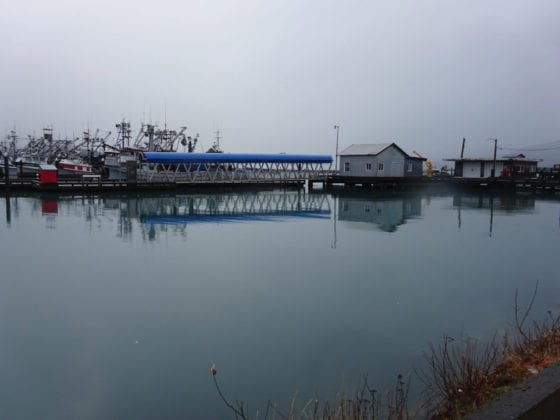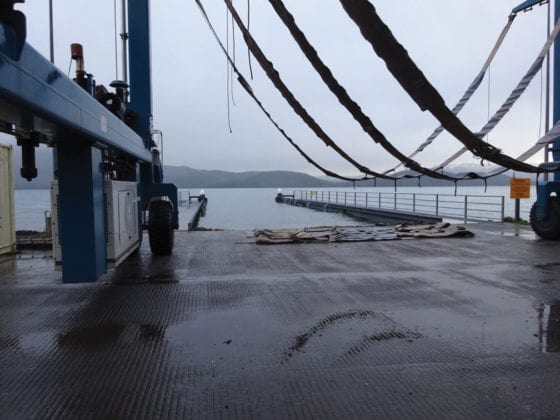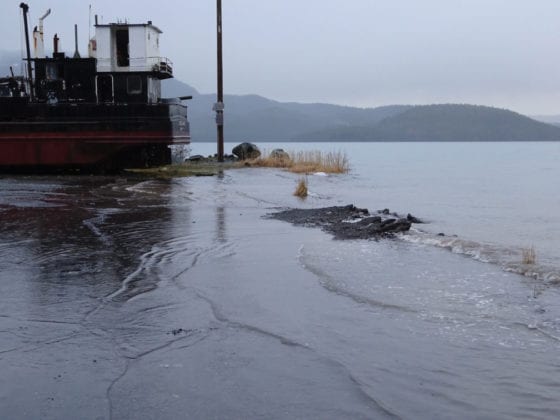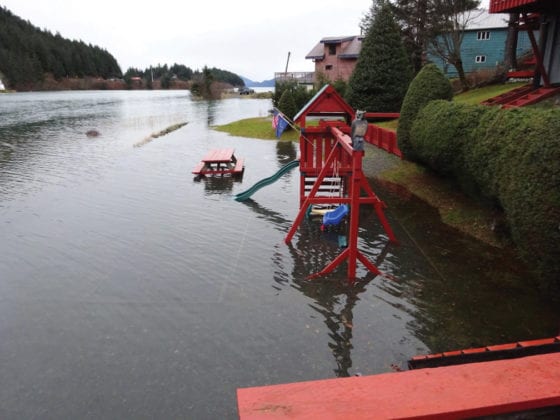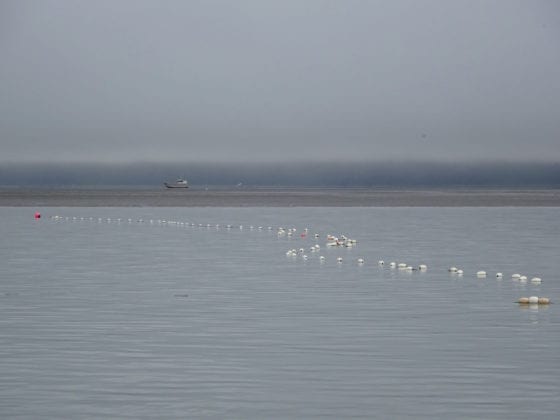When I returned from a hike up the Ski Hill at midday on Nov. 13, I was bit surprised to see the grandkids’ mini-playground on the edge of Odiak Slough flooded with seawater. The sandbox was submerged, the swings were skimming the water’s surface, and we would have had a heck of a time roasting a hot dog in a stone-ringed fire pit that stood out eerily under a foot of salty brine.
It’s mid-November, a classic time for a run of extreme tides, in fact the biggest of the year. I looked at one of a dozen or so tide books scattered around the house (you can never have enough of them), and noted the tide was 15.4 at 11:50 am. But it was to get better. On 15 November the Man on the Moon would create a 16.1 tide at 1:18 pm. There is only one other 16- foot tide predicated in the tide book for 2016, that being a perfect 16.0 on 14 December.
The reason I said the Man on the Moon is because Huck, my four year old grandson from land-locked Austin, Texas, is fascinated by the comings and goings of water in the slough, and about the best I could come up with for an explanation was The Man on the Moon does it.
Which I suppose is somewhat true, but a pretty pathetic explanation from a guy who majored in mathematics at Oregon State. The predication of tides to within one-tenth of a foot and within a minute’s time for an entire year has to be one of the more amazing and sometimes overlooked mathematical achievements of our time, especially due to it’s impact right here in Cordova.
Tales abound of gillnetters running their shallow draft, jet-powered bow pickers aground, and sometimes all you have to do is lean on the railing across the street from aptly named Seaman’s Hardware to see the evidence before your very eyes, on the shortcut across tidal mudflats toward Big Point. No wonder almost every business in town has stacks of tide books available free of charge at their checkout counters. Fishermen would be in deep, or shallow, you know what without them.
One of my favorite “grounding” stories goes back to the days when select-growth logging by helicopter was taking place around Cordova. A local fisherman miscalculated badly on how shallow he could take a shortcut across the upper edge of the Flats, and ended up very high and dry on a big run of tides. Realizing he might miss several key early season openers, he hired a big logging chopper to pull his vessel off. Evidently there was some miscommunication between he and the overhead whirly bird, because it took off dragging the boat to the nearest water before he could get aboard. The story goes someone has video of a fisherman fully-clad in Helly Hansons racing after his boat across slippery mud before doing a belly flop as his bow picker merrily slides into the water.
On a more historical note, the very existence of Cordova as we know it dates back to big November tides in 1907. At that time, rival companies were trying to build railroad routes from Katella, Cordova, and Valdez to reach copper discovered in the Kennicott area.
In her book The Copper Spike, Lone E. Janson describes attempts to construct a dock and breakwater into the exposed Gulf of Alaska at Katalla. She mentions how the Katalla Herald continued to present cheerful news about the dock/breakwater project, “until that third week in November.” Janson added: “ It is certain the worst storm of 1907 occurred, as it frequently does, concurrently with the highest tides of the year (generally in November), greatly increasing the damage done by the storm.”
She also mentioned that a tide surge, driven by strong southeast winds, pushed water all the way up into Main Street of Katalla, reaching its highest at 11:45 on Monday, Nov. 18. Ships had already been having troubles docking at Katalla, and this was the final blow.
A TOWN IS BORN headlined a section in Janson’s book, followed by a “To Move to Cordova” notice from an early December 1907 edition of that town’s newspaper. Katalla’s 13 bars vanished almost over night, and one of them became the famous back bar that still stands in Cordova’s Alaskan Bar.
All this happened 109 years ago, almost on the same date as Cordova’s highest tide in years, just last week.
And maybe my Man on the Moon story to Huck wasn’t so far off base after all. On Nov.14, 2016, the moon will be the closest to the earth in 69 years, creating what has been called a Super Moon, the biggest view of that shiny orb since 1948.
It will also create a rare 16- foot Super Tide in Cordova, a city born of tides over a century ago.
